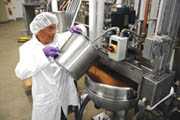
Founded in 1921, See's is headquartered in South San Francisco, with one plant there and another in Los Angeles. During peak seasons-Christmas, Valentine's Day and Easter-See's has more than 6,000 employees. More than 100 varieties of chocolates and candies are sold through 200 See's shops in the West. While the variety attracts customers, it poses a major challenge since each type of candy has a unique shelf life. For example, chocolates and truffles have a shelf life of 55 days; for firmer candies like caramels, it's closer to 70 days and for lollipops, 180 days. With such dramatic variances, it is critical to plan the manufacturing process perfectly to avoid stale products and stock-outs.
Due to the highly seasonal nature of the candy business, See's plants are constantly ramping production up and down. For example, during the Christmas season, See's produces 10 million pounds of candy between September 1 and December 15. Eighty percent of its product is sold between December 15 and the 25.
"Literally, on December first, we start a laborious decision-making process," says Eileen Duag, director of product support for See's. "Over the next two weeks, we revise our schedule minute-by-minute to be sure we don't have any shortages or excess inventory. For years, we've done this manually with a spreadsheet. We've done a good job, but it's tedious and time-consuming, and every second we waste costs money."
For these reasons, the company wanted to improve its scheduling process. Its major objectives included providing cost-efficient production schedules that would be easy to manage and eradicating spreadsheets at key operational and financial points.
"We needed schedules that reflected critical business targets including customer service, cost-per-case, labor utilization and costs, material costs and capacity utilization," says Duag. "We wanted the flexibility to reschedule as frequently as changes in demand dictated so customers could minimize the carrying costs of finished goods and avoid stock-outs." See's calls this build-to-consumption.
To meet these objectives, See's chose the JRG Factory Scheduler, a graphical production scheduling system. The scheduler takes demand as an input and balances forecasts or actual orders against available material, labor and capacity. A key ability of the system is the JRG Adaptive Learning technology, which captures and applies the expert knowledge of planners.
"We've relied on two massive spreadsheets to manage our entire production and packaging scheduling process," says Duag. "It amazes me that the inventory manager made sense of these every week. Before JRG, each step required a tremendous amount of manual effort, wasting management time on clerical work."
By creating a single, automated system, See's has eliminated the spreadsheets, and the massive amounts of data they contained are now readily available, as well as easy to read and analyze. Most importantly for See's, its plant managers can now redirect their focus on the most important aspect of the business-their people.
"When our plant managers don't have to spend all of their time in the office crunching numbers, they can put their focus where it's most valuable-managing and training people," says Duag. "Our analysis shows that giving our managers 20 more hours per week on the floor-versus in the office-translates into more than half a million dollars in annual savings."
For more information:
Brittany Lauer, JRG,
blauer@jrg.com,
866-JRG-SOFT